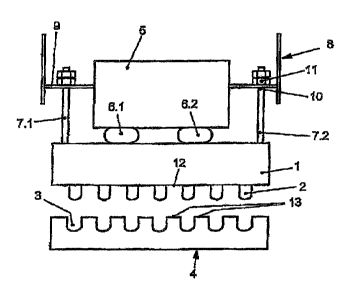Some of the information on this Web page has been provided by external sources. The Government of Canada is not responsible for the accuracy, reliability or currency of the information supplied by external sources. Users wishing to rely upon this information should consult directly with the source of the information. Content provided by external sources is not subject to official languages, privacy and accessibility requirements.
Any discrepancies in the text and image of the Claims and Abstract are due to differing posting times. Text of the Claims and Abstract are posted:
| (12) Patent: | (11) CA 2605713 |
|---|---|
| (54) English Title: | DEVICE FOR THE PRODUCTION OF CONFECTIONERY |
| (54) French Title: | DISPOSITIF SERVANT A FABRIQUER DES CONFISERIES |
| Status: | Deemed expired |
| (51) International Patent Classification (IPC): |
|
|---|---|
| (72) Inventors : |
|
| (73) Owners : |
|
| (71) Applicants : |
|
| (74) Agent: | NORTON ROSE FULBRIGHT CANADA LLP/S.E.N.C.R.L., S.R.L. |
| (74) Associate agent: | |
| (45) Issued: | 2013-09-17 |
| (86) PCT Filing Date: | 2006-03-27 |
| (87) Open to Public Inspection: | 2006-10-26 |
| Examination requested: | 2011-01-04 |
| Availability of licence: | N/A |
| (25) Language of filing: | English |
| Patent Cooperation Treaty (PCT): | Yes |
|---|---|
| (86) PCT Filing Number: | PCT/EP2006/002770 |
| (87) International Publication Number: | WO2006/111244 |
| (85) National Entry: | 2007-10-18 |
| (30) Application Priority Data: | ||||||
|---|---|---|---|---|---|---|
|
The invention relates to a device for the production of confectionery, in
particular, pralines, in moulds (4), with at least one upper die (2) which may
be lowered relative thereto, mounted on a die plate (1) whereby the die plate
(1) has a flexible mounting.
L'invention concerne un dispositif servant à fabriquer des confiseries, en particulier des chocolats, dans des moules (4), en direction desquels au moins un poinçon (2) d'une plaque porte-poinçon (1) peut être abaissé, cette plaque porte-poinçon (1) étant montée de manière flexible.
Note: Claims are shown in the official language in which they were submitted.
Note: Descriptions are shown in the official language in which they were submitted.

For a clearer understanding of the status of the application/patent presented on this page, the site Disclaimer , as well as the definitions for Patent , Administrative Status , Maintenance Fee and Payment History should be consulted.
| Title | Date |
|---|---|
| Forecasted Issue Date | 2013-09-17 |
| (86) PCT Filing Date | 2006-03-27 |
| (87) PCT Publication Date | 2006-10-26 |
| (85) National Entry | 2007-10-18 |
| Examination Requested | 2011-01-04 |
| (45) Issued | 2013-09-17 |
| Deemed Expired | 2020-08-31 |
There is no abandonment history.
| Fee Type | Anniversary Year | Due Date | Amount Paid | Paid Date |
|---|---|---|---|---|
| Application Fee | $400.00 | 2007-10-18 | ||
| Maintenance Fee - Application - New Act | 2 | 2008-03-27 | $100.00 | 2007-10-18 |
| Registration of a document - section 124 | $100.00 | 2008-01-18 | ||
| Maintenance Fee - Application - New Act | 3 | 2009-03-27 | $100.00 | 2009-03-20 |
| Maintenance Fee - Application - New Act | 4 | 2010-03-29 | $100.00 | 2010-03-10 |
| Request for Examination | $800.00 | 2011-01-04 | ||
| Maintenance Fee - Application - New Act | 5 | 2011-03-28 | $200.00 | 2011-03-21 |
| Maintenance Fee - Application - New Act | 6 | 2012-03-27 | $200.00 | 2012-03-12 |
| Maintenance Fee - Application - New Act | 7 | 2013-03-27 | $200.00 | 2013-03-27 |
| Final Fee | $300.00 | 2013-06-27 | ||
| Maintenance Fee - Patent - New Act | 8 | 2014-03-27 | $200.00 | 2014-03-21 |
| Maintenance Fee - Patent - New Act | 9 | 2015-03-27 | $200.00 | 2015-03-27 |
| Maintenance Fee - Patent - New Act | 10 | 2016-03-29 | $250.00 | 2016-03-24 |
| Maintenance Fee - Patent - New Act | 11 | 2017-03-27 | $250.00 | 2017-03-27 |
| Maintenance Fee - Patent - New Act | 12 | 2018-03-27 | $250.00 | 2018-03-26 |
| Maintenance Fee - Patent - New Act | 13 | 2019-03-27 | $450.00 | 2019-04-01 |
Note: Records showing the ownership history in alphabetical order.
| Current Owners on Record |
|---|
| KMB PRODUKTIONS AG |
| Past Owners on Record |
|---|
| KNOBEL, GUIDO |